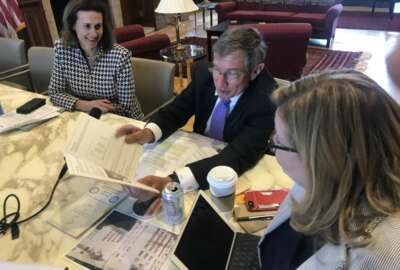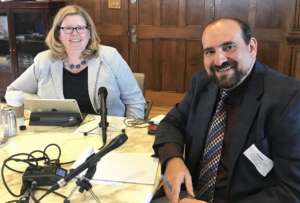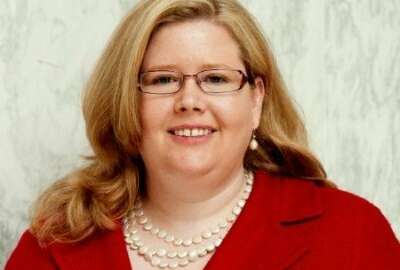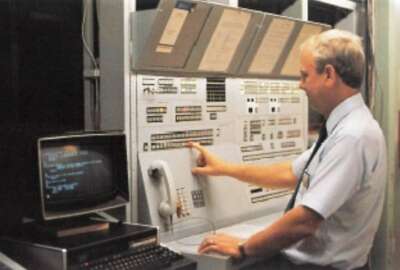
Murphy says collaboration, partnership underlie GSA’s next era
In part two of Federal News Networks’ ongoing special report, GSA @ 70: Mission evolved, Administrator Emily Murphy discusses how this third distinct period o...
This story is part of Federal News Network’s ongoing series: GSA @ 70: Mission evolved
Best listening experience is on Chrome, Firefox or Safari. Subscribe to Federal Drive’s daily audio interviews on Apple Podcasts or PodcastOne.
The modern history of the General Services Administration, say from the mid-1990s to today, includes three distinct periods: The 1990s were a time of adjustment for GSA going from a mandatory source to a fee-based agency. The early 2000s were a time of trouble with some financing and misuse of the schedule contracts.
In part two of the Federal News Networks’ ongoing special report, Administrator Emily Murphy sat down with executive editor Jason Miller to discuss how this third distinct period of GSA history is different from her first stint in the 2000s, and how she is setting the agency’s path forward.
Jason Miller: How has GSA evolved over the last few decades from your perspective?

Emily Murphy: When I first started working in federal procurement, it was back in the mid-1990s. There was a lot of procurement reform back then. If you think back, GSA was actually being proposed to be eliminated. When I first came to work at GSA, I started working in policy. I also worked as a lawyer in private practice and got to do business in front of GSA. I came to government, went to the Small Business Administration before coming to GSA in about 2005 and that was in the middle of the “get it right” scandals. So if you remember, GSA had gone from being a mandatory source to being one where it was a fee-based agency and had gotten really good at developing solutions that its customers wanted. We also got really a little bit ahead of ourselves in terms of some financing and interpretations and misuse of the schedule contracts.
So I spent my first tour of GSA on what I sort of think of as an apology tour. I’m going around from agency-to-agency telling them we were really sorry, we weren’t going to ever do this again. We were going to work with them to make it right, and helping make sure that we were engaging in compliant procurement. It was a tough time for GSA as an agency.
Well now through the Federal Acquisition Service, which was established a little over 12 years ago now, all the synergies that were expected were really starting to materialize. It’s acting as one organization. It’s doing incredibly well business-wise. The Public Building Service is still developing incredible savings. So it’s been sort of fun to watch that progression and also see GSA at a point now where we’re really being embraced by other agencies, by the Office of Management and Budget and by others that we can bring solutions and expertise to the table and, and the agencies are seeking us out with ideas on how to collaborate.
JM: Why do you think that this evolution has been happening? What was it that helped GSA turn the corner in some ways from that apology tour?
EM: The apology tour, again, I think that it was trying to balance out how we do things in a very competitive way and a very customer friendly way, but at the same time do things in a compliant way. I think another way GSA really turned the corner was we came to terms with not being a mandatory source. The second GSA stopped trying to be a mandatory source again, it let us have a different relationship with our customer agencies. They didn’t have to be protective over their space. We really could treat them as a partner or we had something we thought we could bring to the table. We could add value and we wanted to hear from them. We weren’t trying to force one solution on them.
More GSA News

GSA’s Murphy sees another path to reduce commercial pricing burden on vendors
Reporter's Notebook
Read more
Savings of $6.8 billion
More GSA News

GSA’s Murphy sees another path to reduce commercial pricing burden on vendors
JM: The other piece of that though is public building service where in many ways you are a mandatory source. Over the years we’ve seen agencies who’ve tried to go their own way and Congress pushed them back to GSA. But PBS has had a different relationship. You haven’t gone on an apology tour for PBS per se. What is the evolution you’ve seen across PBS?
EM: GSA does offer a fair number of delegations of authority to other agencies when they feel they can do a better job. We’ve got standards and we’re going to hold them to those standards, but we really do work with agencies. PBS has taken a different approach lately. Looking at that customer experience, how can we save money? If we can save a customer agency money, if we can give them better space, if we can have a happier federal employee, then that’s a win for the agency. It’s a win for those employees and it’s frankly a win for the taxpayers. I consider it a success.
When I get to visit a new construction project or a building where we’ve gone and done the redesign and the customer agency wants to give the tour instead of letting the GSA employee give the tour that’s great because they want to show off how great this space is. And I’ve had several of those this year where we’ve cut space by 50% in some cases, but the employees are thrilled with the results and they can do their jobs better, they have more modern space and they’re happier and it’s saved their agencies a substantial amount of money. GSA, overall saved tax taxpayers and our customer agencies $6.8 billion last year and we’re on track to save a fair amount of money again this year.
Looking forward and setting the foundation
JM: There’s an ever-growing demand for GSA’s services, both internally and externally, and there’s a potential a merger happening so how do you ensure that the path or the strategy going forward is able to support all those needs?
EM: I have my initiatives as the GSA administrator. But I also know that whoever comes after me is going to have their initiatives just as the administrators before me had their initiatives. Many of those end up becoming foundational for the next group. In addition to my three priorities where I’ve been focusing on the federal marketplace, strategic leasing and shared services, I’ve also been focusing on what I consider the four key capacities GSA needs. That’s really looking at everything from, IT modernization, customer experience, data and analytics and change management. Frankly, at the end of the day, how can we do a better job of all of those? If I can help implement those, it’s going to help GSA expand to meet the needs our customers come to us with in a way that I couldn’t even begin to imagine today.
First and foremost though, it’s the people and how do we make sure we’re recruiting the right people, that we keep those people, we retain them and that we are reskilling them. There’s some great stuff that’s going on in the CFO’s office right now where we’re teaching people to code so that we can actually help them do some of the robotics process automation (RPA). And also how do we recognize people who are doing a great job and make sure that they feel good about what they do.
JM: What is the one area that you are spending more time on or want to make sure that this is on the right path for the next administrator?
EM: In addition to those four areas that we are trying to really inculcate those, I’ll give you four areas that I’m working on. First one is robotics process automation and just really tracking what we’re doing there. We learned that we couldn’t just think of it as RPA, but it’s really looking at as an eliminate, optimize and automate program. We’ve been able to save 70,000 hours worth of GSA labor so far and we’ve got another 200,000 hours identified that we’re going to be addressing. There’s really a lot of opportunity there and that’s going to give GSA back some resources it sorely needs to be doing sort of higher-dollar value work or higher-mental value work than data entry.
The second area is the federal marketplace. It’s one I’m just really passionate about — schedules consolidation and all the promise that brings. That’s going to be transformational for the GSA schedules program, for our workforce, for our vendors and for our customer agencies.
The lease cost savings work that we’re doing right now and the cost avoidance again, that if we can do that, if we can get better data on building utilization, there is a lot of savings that can be returned to taxpayers. We’re tracking right now that for the new leases we’ve been putting in place this year, we’re about 20% below market value. That’s a really great story to be telling and it’s going to have savings that will last for 10 to 15 years going forward.
The fourth one is shared services. The work that we’re doing on payroll first, but also looking at the other types of transactional work GSA can take on or work with other agencies to facilitate the transition to the appropriate place so that we’re not duplicating each other’s efforts. Again, it’s not about becoming a mandatory source, it’s about making sure that we aren’t all just doing the same thing again and again without that added value. If I can get those four things done, I think I’ll have left or at least had the foundation in place for those, then I think GSA will be a stronger place in the future, in the future.
Copyright © 2024 Federal News Network. All rights reserved. This website is not intended for users located within the European Economic Area.
Jason Miller is executive editor of Federal News Network and directs news coverage on the people, policy and programs of the federal government.
Follow @jmillerWFED





